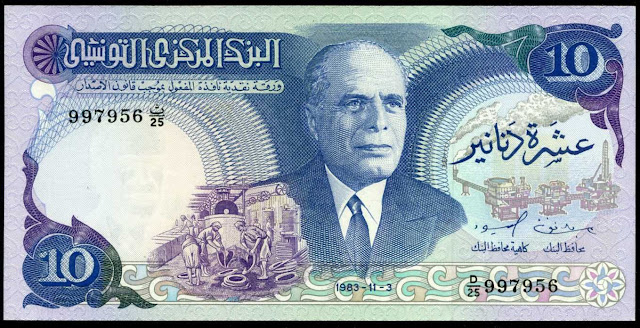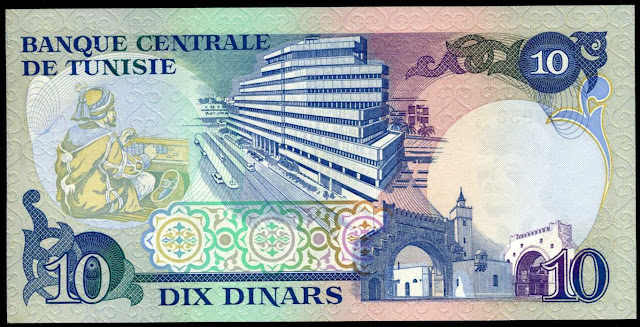Tunisia Banknotes 10 Dinars banknote 1983 President Habib Bourguiba
Central Bank of Tunisia - Banque Centrale de Tunisie
Obverse: Portrait of Habib Bourguiba at center (full name: Habib Ben Ali Bourguiba; 1903 – 2000) was a Tunisian statesman who became the country's first President of the Republic of Tunisia from 1957 to 1987. The note denomination is indicated in arabic figures and letters. The traditional production of olive oil at lower left center, offshore platforms in the Mediterranean sea at right. The Ashtart oil field is located in 215 feet of water in the Gulf of Gabes offshore Tunisia. Ashtart was discovered in 1971 and was placed into production in 1974. Pressure in the 215-foot-thick reservoir is maintained through seawater injection. The field produces roughly 12,000 Bopd. Produced gas is used for fuel and gas-lift with the remainder being flared off.
Reverse: Jewish money changer in Tunisia at left, Central Bank of Tunisia Building in Tunis at center, Arch of Bab El Khadra at right.
Watermark: Portrait of President Habib Bourguiba.
Color: Blue and lilac on multicolor underprint.
Dimensions: 170 x 85 mm.
Date of issue: 26.05.1986.
Date of withdrawal: 30.06.2003.
Tunisia Banknotes - Tunisia Paper Money
03.11.1983 Issue
Bab El Khadra
Bab El Khadra is one of the gates of the medina of Tunis, the capital of Tunisia. The original structure, a simple arch erected in 1320 was destroyed and rebuilt in its current form in 1881 by the French colonisers in order to facilitate commerce. It has a distinctly European style and resembles the gates of a European castle.
Money changer
A money changer is a person who exchanges the coins or currency of one country for that of another. This trade is thought generally to be the origin of modern banking in Europe.
The advent of paper money in the mid-17th century and the development of modern banking and floating exchange rates in the 20th century allowed a foreign exchange market to develop. This provided a way for banks and other specialist financial companies such as bureaux de change and forex brokers to change one countries money for another, rapidly, and with the added confidence of transparency.
In ancient times in Jerusalem, pilgrims visiting the Jewish Temple on Jewish Holy Days would change some of their money from the standard Greek and Roman currency for Jewish and Tyrian money, the latter two the only ones accepted as payments inside the Temple. With this Temple money the pilgrim would purchase a sacrificial animal, usually a pigeon or a lamb, in preparation for the following day's events.
During medieval times in Europe, many cities and towns issued their own coins, often carrying the face of a ruler, such as the regional baron or bishop. When outsiders, especially traveling merchants, visited towns for a market fair, it became necessary to exchange his foreign coins to local ones at local money changers. Money changers would assess a foreign coin for its type, wear and tear, and possible counterfeit, then accept it as deposit, recording its value in local currency. The merchant could then withdraw the money in local currency to conduct trade or, more likely, keep it deposited and use its clearing facility to conduct trade.
In the market, most large transactions were done not by cash/coins, but by transfer order of funds on the books kept at the local money changer(s). After a market/fair ended, merchants gathered at the local money changers and withdrew their deposit in their own different currencies. The rate of exchange between different foreign currencies and the local one were fixed between the opening and the closing days of the market.
As the size and operations of money changers grew they began to provide a lending facility, by putting the fee of the lending in the foreign exchange rates. Later the Knights Templar provided this service to pilgrims traveling to and from the Holy Land.

